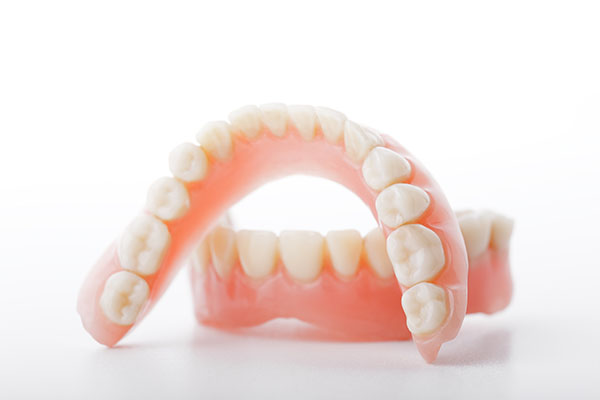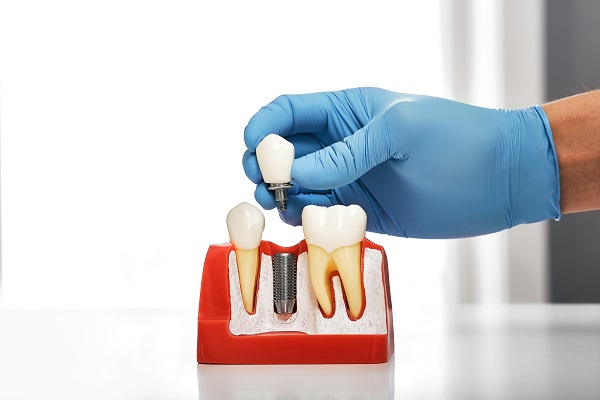Steps For Getting Permanent Dentures Fitted
 Dentures are a way for people to live a normal life after losing their teeth. Regardless of the number of teeth that have been lost, having a set of dentures can allow a person to chew and speak normally, with very little challenge. There are three basic types of dentures that a person can have, based on their needs and unique circumstances. These are full dentures, partial dentures, and immediate dentures. Immediate dentures are the only one that can be installed on the first day. For partial dentures or full dentures, there is a number of steps that we must go through to make sure they are the perfect fit and meet your needs precisely. Typically these steps can be completed over the course of four office visits though sometimes it can take a little bit longer if there are other factors to deal with.
Dentures are a way for people to live a normal life after losing their teeth. Regardless of the number of teeth that have been lost, having a set of dentures can allow a person to chew and speak normally, with very little challenge. There are three basic types of dentures that a person can have, based on their needs and unique circumstances. These are full dentures, partial dentures, and immediate dentures. Immediate dentures are the only one that can be installed on the first day. For partial dentures or full dentures, there is a number of steps that we must go through to make sure they are the perfect fit and meet your needs precisely. Typically these steps can be completed over the course of four office visits though sometimes it can take a little bit longer if there are other factors to deal with.
Dentures today are very different from the ones installed in the past. They are designed to look and feel like natural teeth, stay securely in the mouth, and have no chance of slipping or falling out. Because of this, we are very careful to ensure that the dentures being made are custom-fitted to your mouth and that your mouth is healthy and ready for dentures, which is where step one begins.
- Preparing for Dentures: The first visit when you are getting a new set of dentures consists of three things. First we will give you a comprehensive examination. This will help determine the overall health of your mouth, find any challenges that may occur, and give us the opportunity to correct any lingering problems that may cause issues with the dentures later on. One example of things we find is sometimes patients have an excess of flabby tissue on their gums which can affect the fit of the dentures. In cases like this we recommend removing the excess fat, so that fit of the false teeth is not affected. We also take a series of x-rays to make sure that the underlying bone structure will be complimentary to the denture fittings. Next, we will take an imprint of the gums with poured plaster. The plaster implant gives the laboratory a life-size replica of your gums from which they can create the new dentures. Finally, we will discuss the size, shape, and shading of your new teeth.
- CJR (central jaw relation), or the MMR (maximum mandibular retrusion): On the second visit we will be working to make sure that the teeth being made are the right size and are aligned so that there is no clicking while speaking or chewing. This is done by using a loose-fitting denture base and wax rims, to simulate teeth, which are adjusted until they are a perfect fit. Once this relationship is perfect, we will send the rims to the laboratory to fabricate the teeth themselves.
- Wax Fitting: During the third visit you will get to see the actual teeth and try them on. The difference being that the teeth will be embedded in wax instead of the final plastic, and the base will still be loose enough to slide over the gums. This fitting allows us to get the final measurements and send any adjustments to the laboratory, which will then make the final product.
- Leave with dentures: On the fourth visit, barring any complications, we will make some final adjustments to the plastic and then you will leave with a brand new set of teeth.
Cosmetic Dentist
Dental ImplantsRecent Posts
A set of implant supported dentures can restore a smile by creating a permanent set of artificial teeth. The first benefit of permanent or fixed dentures is that they function like natural teeth, which means no slippage. The second upside of implant-supported dentures is their contribution to the health of the jaw.A missing tooth leaves…
Looking into your denture choices? implant supported dentures are a popular choice due to the many advantages that they offer. Those who choose this denture option need to first have a certain number of dental implants placed in their jawbone, making this a multi-month procedure.Considering getting implant supported dentures but want to learn more about…
Many dental professionals recommend dental implants restoration after tooth loss. Dental implants offer superior durability and functionality and look just the same as natural teeth. However, some patients are nervous about the success rate of dental implant restoration, and learning more about what the stats say can help you physically and mentally prepare yourself. According to…
Cavities are a common oral health concern that dentists can treat with restorative dentistry. While common, leaving cavities untreated for an extended amount of time can lead to severe complications, including tooth infection, dental abscess, deep tooth decay, and the loss of teeth.The good news is that treating dental cavities is relatively easy for dentists…


